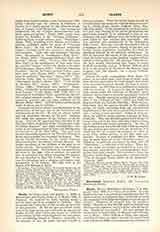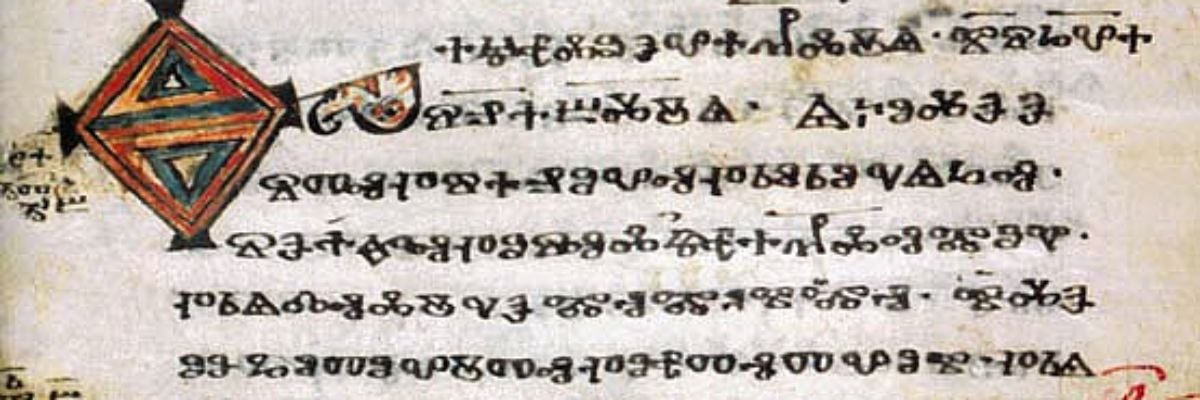

Glagolitic (or GLAGOLITSA; Slavonic glagol, a word; glagolati, to speak). An ancient alphabet of the Slavic languages, also called in Russian bukvitsa. The ancient Slavonic when reduced to writing seems to have been originally written with a kind of runic letters, which, when formed into a regular alphabet, were called the Glagolitic, that is the signs which spoke. St. Cyril, who, together with his brother St. Methodius, translated the Greek liturgy into Slavonic when he converted the Bulgarians and Moravians, invented the form of letters derived from the Greek alphabet with which the church Slavonic is usually written. This is known as the Cyrillic alphabet or Kirillitsa. The Cyrillic form of letters is used in all the liturgical books of the Greek Churches, whether Catholic or schismatic, which use the Slavonic language in their liturgy, and even the present Russian alphabet, the Grazhdanska, is merely a modified form of the Cyrillic with a few letters omitted. The order of the letters of the alphabet in the Glagolitic and in the Cyrillic is nearly the same, but the letters bear no resemblance to each other, except possibly in one or two instances. Jagie upholds the theory that St. Cyril himself invented the Glagolitic, and that his disciple St. Clement transformed it into Cyrillic by imitating the Greek uncial letters of his day. There is a tradition, however, that St. Jerome, who was a Dalmatian, was the inventor. Some of the earliest Slavic manuscripts are written in the Glagolitic characters. The Cyrillic alphabet continued to be used for writing the Slavonic in Bulgaria, Russia, and Galicia, while the Southern and Western Slays used the Glagolitic. These Slays were converted to Christianity and to the Roman Rite by Latin missionaries, and gradually the Roman alphabet drove out the use of the Glagolitic, so that the Bohemians, Slovenians, Moravians, and part of the Croatians used Roman letters in writing their languages. In Southern Croatia and in Dalmatia (often treated as synonymous with Illyria in ancient times) the Glagolitic has continued in use as an ecclesiastical alphabet in writing the ancient Slavonic. Although the Slavic peoples bordering on the Adriatic Sea were converted to the Roman Rite, they received the privilege, as well as their brethern of the Greek Rite, of having the Mass and the offices of the Church said in their own tongue. Thus the Roman Mass was translated into the Slavonic, and, in order to more fully distinguish the Western Rite from the Eastern Rite among the Slavic peoples, the use of the Glagolitic alphabet was reserved exclusively for the service books of the Roman Rite, just as the Cyrillic was used for the Greek Rite.
The use of the Glagolitic Missal and office books, while permitted in general among the Slays of Dalmatia and Croatia from the earliest times since the Slavonic became a liturgical language under Pope John VIII, was definitely settled by the Constitution of Urban VIII, dated April 29, 1631, in which he provided for a new and corrected edition of the Slavic Missal conformable to the Roman editions. In 1648 Innocent X provided likewise for the Slavic Breviary, and by order of Innocent XI the new edition of the Roman-Illyrian Breviary was published in 1688. In the preface to this Breviary the pope speaks of the language and letters employed therein, and gives St. Jerome the credit for the invention of the Glagolitic characters: “Quum igitur Illyricarum gentium, qua, longe lateque per Europam diffusae sunt, atque ab ipsis gloriosis Apostolorum Principibus Petro et Paulo potissimum Christi fidem edoctae fuerunt, libros sanctos jam inde a S. Hieronymi temporibus, ut pervetusta ad nos detulit traditio, vel certe a Pontificatu fel. rec. Joannis Papae VIII, praedecessoris nostri, uti ex ejusdem data super ea re epistoler constat, ritu quidem romano, sed idiomate slavonico, et charactere S. Hieronymi vulgo nuncupato conscriptos, opportune recognitione indigere compertum sit.” The new edition of the Roman Ritual in Glagolitic form had previously been published in the year 1640.
The latest editions of the Missal and ritual are those of the Propaganda, “Missale Romanum, Slavica lingua, glagolitico charactere” (Rome, 1893), and “Rimski Ritual (Obrednik) izdan za zapoviedi Sv. Otca Pape Paula V” (Rome, 1894). There was a former edition of the Glagolitic Missal, “Ordo et Canon Misses, Slavice” (Rome, 1887), but on account of the numerous errors in printing and text it was destroyed, and only a few copies are in existence. The use of the Latin language in the Dalmatian seminaries since the year 1828 has had the effect of increasing the use of the Latin in the Roman Rite there, and the use of’ the Glagolitic books has accordingly diminished. Of course the non-Slavis inhabitants of Dalmatia and Croatia have always used the Latin language in the Roman Rite. At present the Slavonic language for the Roman Rite, printed in Glagolitic characters, is used in the Slavic churches of the Dioceses of Zengg, Veglia, Zara, and Spalato, and also by the Franciscans in their three churches in Veglia, one in Cherso, two in Zara, and one in Sebenico. Priests are forbidden to mingle the Slavonic and Latin languages in the celebration of the Mass, which must be said wholly in Slavonic or wholly in Latin.
ANDREW J. SHIPMAN


